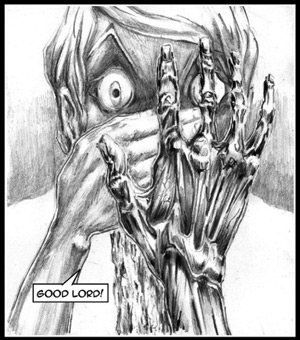Ever heard the one about how to make a small fortune? Start with a large fortune and go into publishing.
 I was reminded of that when I finished tallying my financial numbers for this column. Not that I had a large fortune – or any fortune – but you get the point. This installment, the final of this run, shows you the real numbers from a year in the financial life of making Split Lip.
I was reminded of that when I finished tallying my financial numbers for this column. Not that I had a large fortune – or any fortune – but you get the point. This installment, the final of this run, shows you the real numbers from a year in the financial life of making Split Lip.
And it’s not the prettiest picture, really. But more on that in a minute.
I looked at the 12 months from July 2009-June 2010. This isn’t a completely representative year, but it’s the most recent 12-month period. It’s not entirely representative because it covers the first month after the 6-month layoff and includes more printing expenses than a normal year would (due to the printing of multiple books), but it serves its purpose.
I’m a bit apprehensive about sharing these numbers, truth to be told, but I hope that they’re a useful dose of reality for people considering self-publishing comics. They certainly have been for me.
Website Traffic
I track my stats using two services – StatCounter and Google Analytics – and they return different results and track different things. The space between them probably represents something like the truth.
To understand this, you need to know the following:
- Pageviews – the total number of pages viewed by all visitors to the site
- Unique visitors – individual people visiting the site (does not include repeat visits by the same person)
- Total visitors – All visits, including repeats
|
|
Total Pageviews |
Unique Visitors |
Total Visitors |
Repeat Visitors |
Best Month |
Worst Month |
|
StatCounter |
357,961 |
83,227 |
N/A |
6,072 |
Oct. |
July 2.5K visitors |
|
Google Analytics |
305,624 |
10,314 |
21,239 |
N/A |
Oct. |
July 796 visitors |
Not a terrible set of numbers (taken this way, rather than a January-December year, this is my best single year of traffic), but keep in mind that many other webcomics do 10x or more than this traffic. Some get 5,000-10,000 visitors a day. Needless to say, I’m a long way from that.
Financials
Here’s where things get really upset— er, interesting.
Income (in US$)
Books + minicomics sold, in units: 145 (doesn’t include 15-20 books sold prior to this period)
Revenue from books + minicomics: $1,611.50
Total t-shirts sold,: 1 (not counting the big bump Boing Boing gave me last week; include that and t-shirt sales are close to 50 and revenue from them close to $700)
Revenue from t-shirts: $15
Website ad/affiliate revenue: $106.40 (this dropped significantly after Amazon disallowed its affiliates program in Rhode Island, where I live, thanks to a short-sighted tax-law change by our legislature).
Total income: $1,782.90
Expenses
Total page-rate paid to artists: $4,584.40
Cons (registration, tolls, hotels – not including meals): $1,915.07
Advertising: $530.93
Printing (books + shipping): $1,359.93
 Printing (t-shirts + shipping): $778.75
Printing (t-shirts + shipping): $778.75
Royalties paid to artists (2009): $477.14
Total expense: $9,646.22
The bottom line: A loss of $7,863.32
I was a little light-headed after seeing that bottom line number. That’s a lot of money to lose. And that’s just one year.
Now, I’m very lucky: I have relatively few expenses and a well-paying job, so losing that money isn’t going to put me in the street. But a couple of years like that might.
So, how to think about this spent money, and what do I do about it in the future?
I could decide to view Split Lip as my favorite hobby, which would release me from ever needing to show a profit. It’s not unreasonable for people to spend a decent amount of money every year on their passions, but if Split Lip is my hobby, I spend $655/month on it. That’s a lot.
Maybe it’s better to look at that number as being part of the expenses required to ramp up a new business. Most businesses lose a good deal of money in their first five years; in fact, most businesses don’t survive to see their fifth birthday (Split Lip turns four in October).
And maybe with a few more years’ hindsight, that’s how I’ll see this. An investment in the future. Maybe.
Probably I should view a good chunk of it as the result of mistakes that I’ve made and written about already.
I’d wager I’ll end up thinking about it in all those ways, but writing this column has helped me realize that I have to make some changes. Those changes will include:
- creating a new site (done), driving traffic to it (working on it), and expanding the advertising networks I use to generate more revenue (already underway)
- better controlling how much I pay artists, without low-balling my collaborators or losing out on quality work
- going to fewer cons, or more local ones that require lower total expense (already in the works)
- trying again to find a publisher who will pay to print, advertise, and distribute the books (I have some ideas)
- barring that, take pre-orders to cover all future printing costs on books and t-shirts so my initial loss on those is reduced to zero (watch for the first of these this fall).
Taking those steps won’t get me to break-even, but it will bring it closer — close enough that increased sales might close the gap.
****
And that, friends, is where I’m leaving you. With challenges and some tough realities, but also with ideas about how to attack them, and with hope. My numbers aren’t the only possible outcome; other indie creators have very different numbers and show healthy profits. Making indie comics on your own is challenging. It can be frustrating. It can, as we see, be expensive.
But it’s also a great challenge, a way to meet terrific people, and a lot of fun.
I hope those of you kind enough to read this column through to its fourth installment have learned something from the things that I’ve done well and not so well (I’ve certainly learned some things!). I hope you’re able to use that information to make your own comics.
I’m looking forward to reading them.


The cost i was surprised at the most was for the printing and shipping of books. When you print, do you do a large number of units at one time, or do you so smaller amounts as you need them? my biggest concern with self publsihing has always been whether or not i could afford to print my book(s). do you feel this price is too much for printing?
Thanks again for these articles Sam, and thanks to you ifanboy. This has been a great motivator for me, and i hope a lot of other members who want to write comics. And anything you need Sam, be it shamless promotion, I may be up fo that!
One of my favorite new features at iFanboy, and you’ve inspired me to start my own. Thanks again for sharing your knowledge and I really hope you continue to write for us.
I’m also kind of curious to hear if Jason Wood has any insight on these numbers.
@Sam: This has been very enjoyable and insightful. I hope you write another series of articles on here soon!
Thanks guys! Glad you’ve enjoyed them – here’s hoping I’m back with some more of these articles sooner rather than later.
@WeaklyRoll – Even though I use POD, I generally print a decent number of books at one time to make sure I have inventory for cons, taking to stores, and online sales. I generally buy about 100 TPBs in one order, and 25-50 minicomics. On a per-unit basis, the price feels pretty good to me. It’s not as low as offset printing, of course, but I don’t have a minimum order, which saves money. If I felt I could move 1,000-2,000 books, I’d definitely use offset, but the price would be at least double, maybe more.
Thanks for the offer, too – I may well take you up on that!
@Sam–have you ever looked into using a digital press like the HP Indigo through an offset print house as opposed to using POD? TPB’s and floppies are incredibly simple print/bind jobs and i’m sure you could get some competitive quotes that might might help your bottom line. POD is marked up because of the service they are selling you.
Really enjoyed reading this, great insight into the publishing world, I like the idea that this is your hobby…. it just costs alot….. like 152/week, maybe like a car the eats fuel like the blog does food…… or renting a small flat.
@Wally – Interesting suggestion. I haven’t looked into that kind of thing, no. Do you have any sense of what kind of unit cost that printing produces? The POD place I use has great rates (much, much better than the more well-known comics POD houses), but I’m always interested in saving money.
@LukeB – It’s funny, my girlfriend said the same thing when we were talking about it – people spend a lot of money on their classic cars, this is your version of that. I might need to buy a little less gas, though. 🙂
Thanks for posting your articles about Split Lip, it great to read your journey into the reality of self publishing, and illustrates some great advice, and points. I’ll definitely check out your site.
Thanks so much for posting this great series. Smart marketing move, too. Your website is really nicely done as well. I’ve been publishing comics for a similar period of time, and it’s fascinating to compare notes and stats.
What advertising do you use? Just Google? What others are you expanding to?